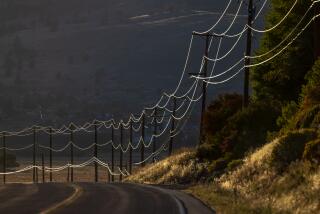PG&E tells Northern California customers it may shut off power again as the state faces fire threat

Pacific Gas & Electric notified thousands of customers that it may shut off power across Northern California in preparation for extreme fire danger.
Dry vegetation, low humidity levels and strong Santa Ana winds have prompted fire warnings across the state, indicating that any fires that start are likely to spread rapidly, the National Weather Service said Wednesday.
In the North and East Bay hills, gusts are expected to reach up to 60 mph with sustained winds of 15 to 30 mph and low humidity levels, even overnight, the weather service said.
As a result, PG&E announced it may turn off power starting Thursday to Butte, Lake, Napa, Nevada, Placer, Plumas, Sierra, Sonoma and Yuba counties. The utility sent automated voice messages, texts and emails to 70,000 customers.
“We know how much our customers rely on electric service and the impacts these events can have on our customers, their families and communities,” Pat Hogan, senior vice president of Electric Operations for PG&E, said in a statement. “We will only consider temporarily turning off power in the interest of safety and as a last resort during extreme weather conditions to reduce the risk of wildfire.”
It would be the second time in less than a month the utility has taken a proactive approach in preventing fires by shutting off its power lines. In mid-October, PG&E notified 97,000 customers that it could turn off their power. The utility eventually shut off power to about 60,000 customers, according to spokeswoman Jennifer Robison, who added that the utility can’t predict when shutoffs are ordered.
“We’re continually looking at weather forecasts throughout the afternoon and early evening,” Robison said. “We’re going to be looking at wind speeds, humidity levels and how low they get. We have people on the ground who can tell us how things look out there.”
In Napa, Lake and Sonoma counties, an electrical shutoff would be the second in just over three weeks.
The move is part of a strategy by utilities across California to reduce the risk of wildfires sparked by utility lines that break during extreme winds. Many of California’s most destructive fires — including several that raced through wine country last year — were attributed to power lines.
In late October, Southern California Edison admitted its equipment likely sparked at least one starting point of the Thomas fire that roared through Ventura and Santa Barbara counties in late 2017. Two deaths are attributed to that blaze, the second largest in California history with 281,893 acres burned.
Weather experts in Southern California were monitoring conditions Wednesday morning and upgraded a fire watch to a red flag fire warning. Strong Santa Ana winds in Los Angeles and Ventura counties will begin Thursday morning and peak in the evening, with gusts reaching up to 50 mph in the valleys and coasts and 70 mph in the mountains. Those regions will be extremely dry with poor overnight recovery, the National Weather Service said.
Fire weather also is threatening San Diego and Orange counties, with winds of up to 60 mph affecting areas near the Cajon Pass, western parts of the Inland Empire and across the foothills of San Diego County, meteorologist Dan Gregoria said.
“If we get any fire starts, they would be prone to be fast-moving and dangerous,” Gregoria said.
Winds in most areas where a fire warning is in effect will diminish Friday evening, but gusts are expected to return early next week with continued dry conditions, the weather service predicted.
alejandra.reyesvelarde@latimes.com
Twitter: @r_valejandra
UPDATES:
11:15 a.m.: This article was updated with fire watch details across Southern California and a comment from Pacific Gas & Electric.
This article was originally published at 10 a.m.
More to Read
Sign up for Essential California
The most important California stories and recommendations in your inbox every morning.
You may occasionally receive promotional content from the Los Angeles Times.











